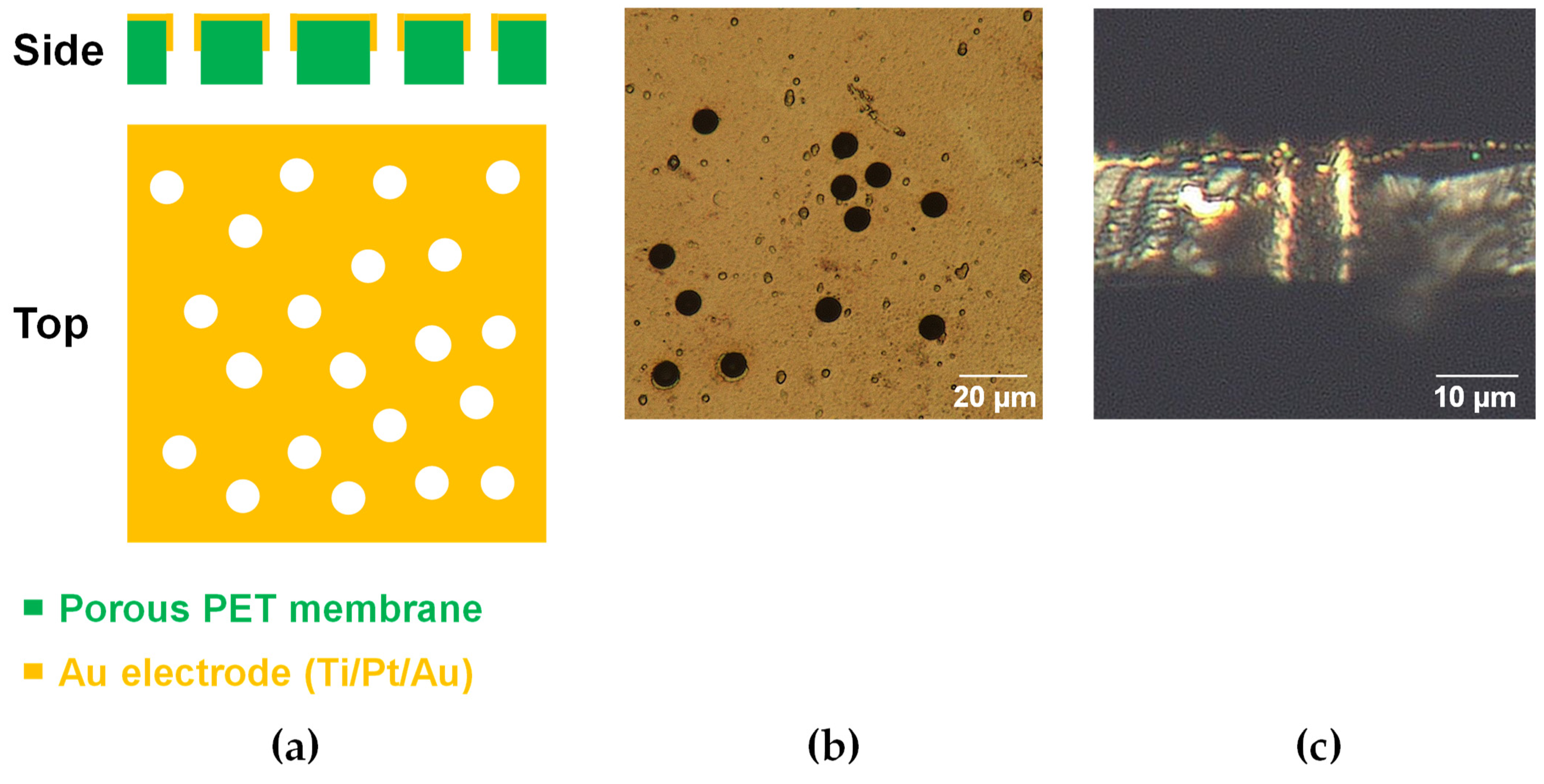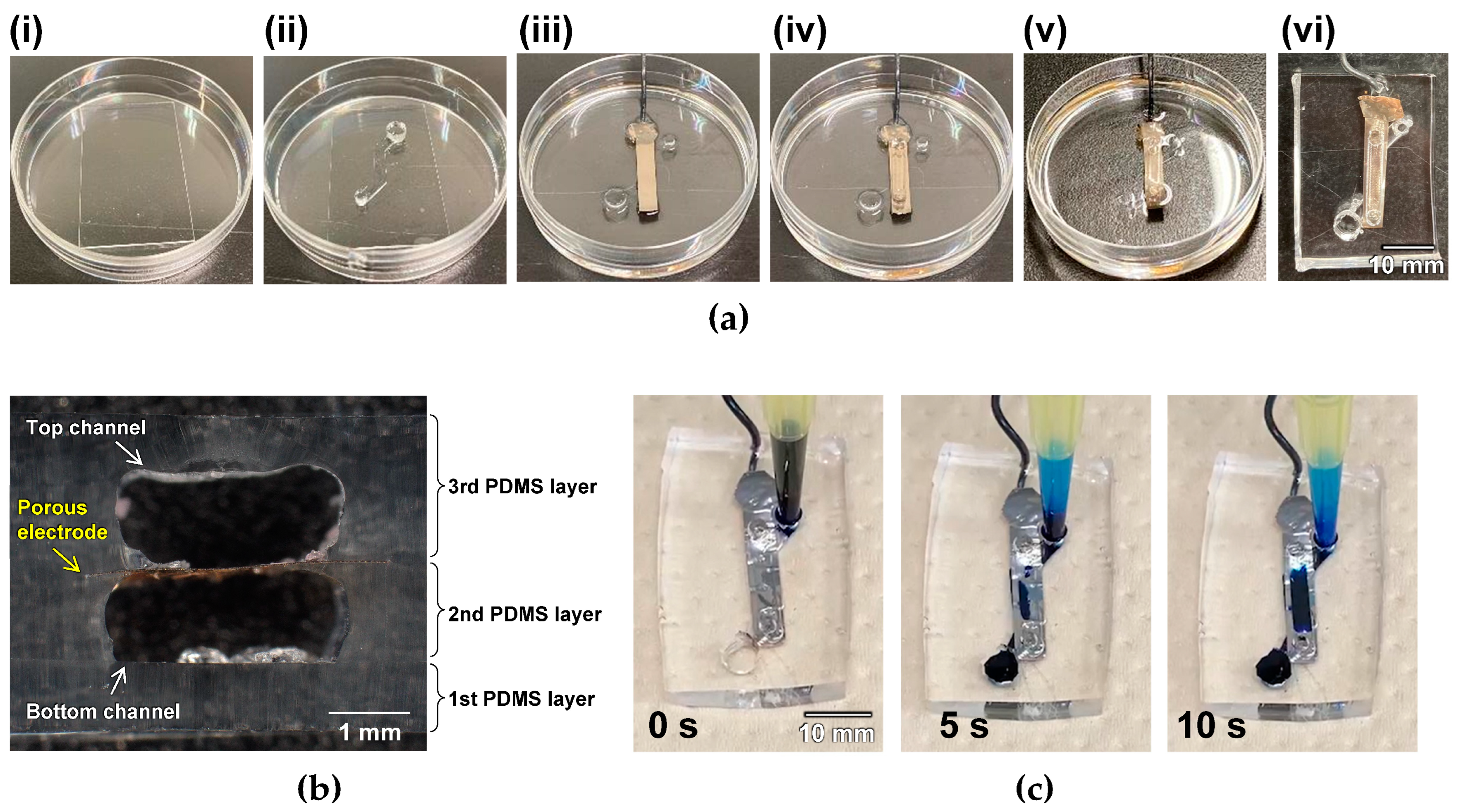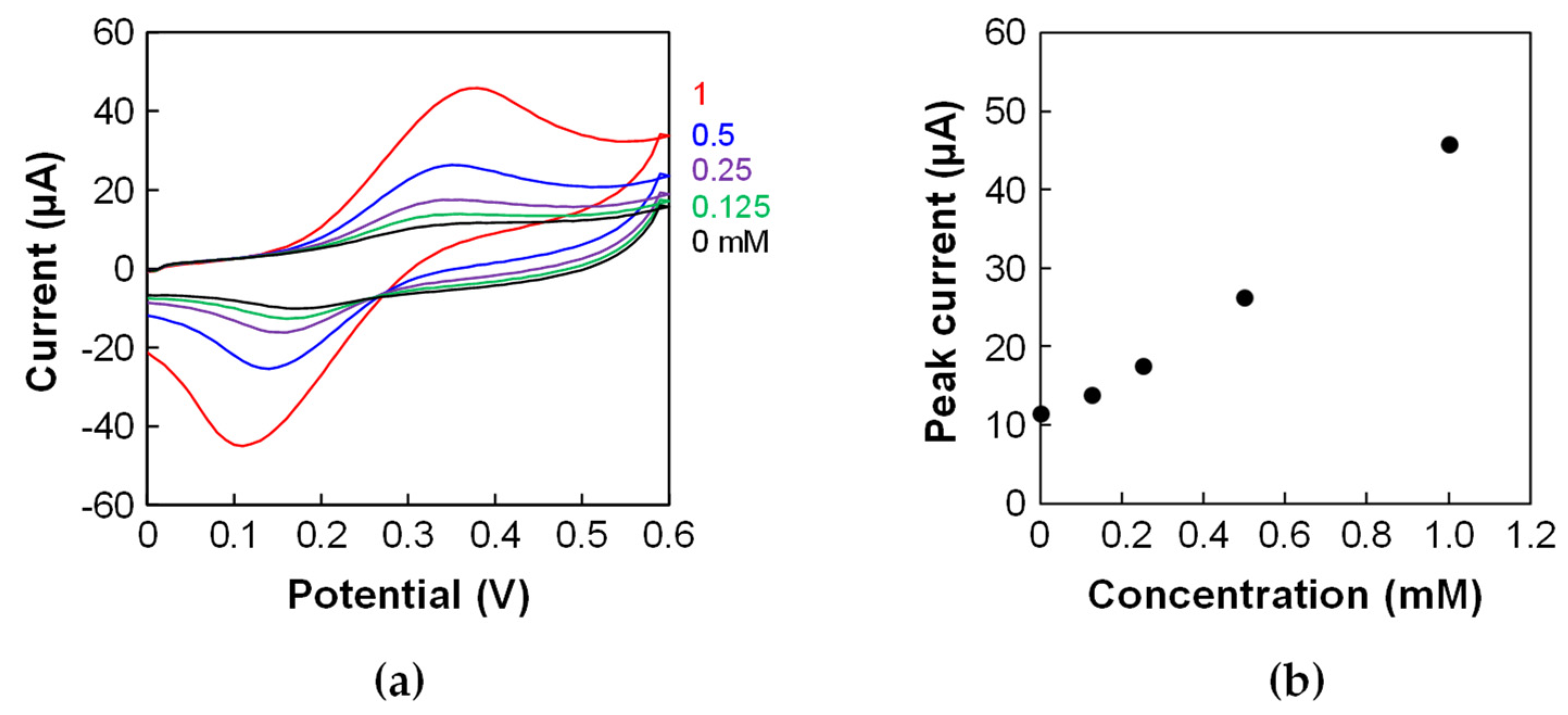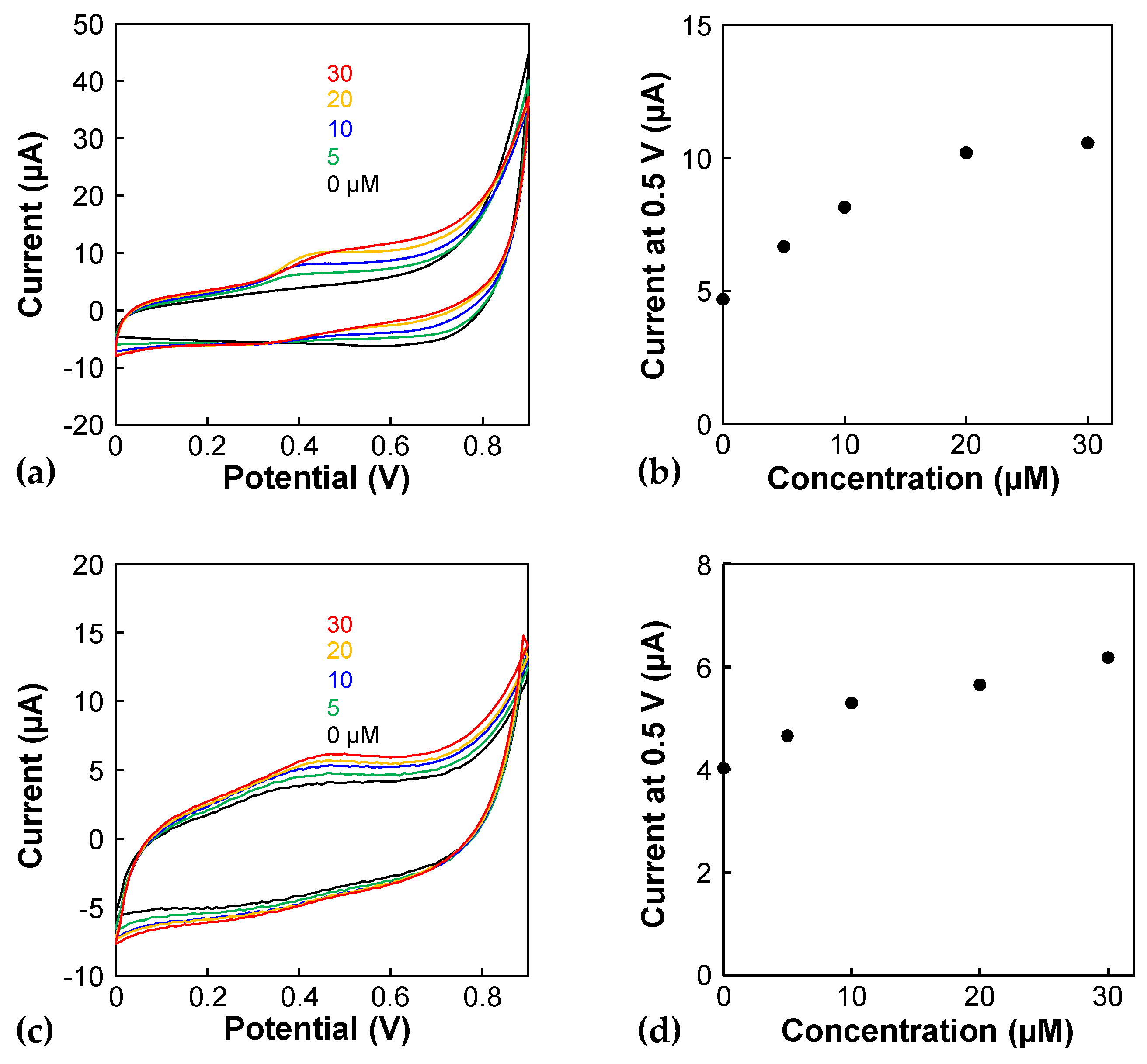Fabrication of Two-Layer Microfluidic Devices with Porous Electrodes Using Printed Sacrificial Layers
Abstract
1. Introduction
2. Materials and Methods
2.1. Device Fabrication
2.2. Cyclic Voltammetry
3. Results and Discussion
4. Conclusions
Supplementary Materials
Author Contributions
Funding
Data Availability Statement
Conflicts of Interest
References
- Ingber, D.E. Human organs-on-chips for disease modelling, drug development and personalized medicine. Nat. Rev. Genet. 2022, 23, 467–491. [Google Scholar] [CrossRef]
- Utagawa, Y.; Ino, K.; Hiramoto, K.; Iwase, K.; Nashimoto, Y.; Honma, I.; Shiku, H. Vasculature-on-a-chip with a porous membrane electrode for in situ electrochemical detection of nitric oxide released from endothelial cells. Anal. Chem. 2023, 95, 18158–18165. [Google Scholar] [CrossRef] [PubMed]
- Chapin, A.A.; Rajasekaran, P.R.; Quan, D.N.; Hu, L.; Herberholz, J.; Bentley, W.E.; Ghodssi, R. Electrochemical measurement of serotonin by Au-CNT electrodes fabricated on microporous cell culture membranes. Microsyst. Nanoeng. 2020, 6, 90. [Google Scholar] [CrossRef]
- Ramiah Rajasekaran, P.; Chapin, A.A.; Quan, D.N.; Herberholz, J.; Bentley, W.E.; Ghodssi, R. 3D-Printed electrochemical sensor-integrated transwell systems. Microsyst. Nanoeng. 2020, 6, 100. [Google Scholar] [CrossRef]
- McDonald, J.C.; Duffy, D.C.; Anderson, J.R.; Chiu, D.T.; Wu, H.K.; Schueller, O.J.A.; Whitesides, G.M. Fabrication of microfluidic systems in poly(dimethylsiloxane). Electrophoresis 2000, 21, 27–40. [Google Scholar] [CrossRef]
- Huh, D.; Hamilton, G.A.; Ingber, D.E. From 3D cell culture to organs-on-chips. Trends Cell Biol. 2011, 21, 745–754. [Google Scholar] [CrossRef]
- Wyatt Shields Iv, C.; Reyes, C.D.; López, G.P. Microfluidic cell sorting: A review of the advances in the separation of cells from debulking to rare cell isolation. Lab Chip 2015, 15, 1230–1249. [Google Scholar] [CrossRef]
- Zhang, Y.S.; Haghiashtiani, G.; Hübscher, T.; Kelly, D.J.; Lee, J.M.; Lutolf, M.; McAlpine, M.C.; Yeong, W.Y.; Zenobi-Wong, M.; Malda, J. 3D extrusion bioprinting. Nat. Rev. Method. Prim. 2021, 1, 75. [Google Scholar] [CrossRef]
- Ino, K.; Fukuda, M.T.; Hiramoto, K.; Taira, N.; Nashimoto, Y.; Shiku, H. Fabrication of three-dimensional calcium alginate hydrogels using sacrificial templates of sugar. J. Biosci. Bioeng. 2020, 130, 539–544. [Google Scholar] [CrossRef]
- Moeun, B.N.; Fernandez, S.A.; Collin, S.; Gauvin-Rossignol, G.; Lescot, T.; Fortin, M.-A.; Ruel, J.; Bégin-Drolet, A.; Leask, R.L.; Hoesli, C.A. Improving the 3D printability of sugar glass to engineer sacrificial vascular templates. 3D Print. Addit. Manuf. 2022, 10, 869–886. [Google Scholar] [CrossRef]
- Homan, K.A.; Kolesky, D.B.; Skylar-Scott, M.A.; Herrmann, J.; Obuobi, H.; Moisan, A.; Lewis, J.A. Bioprinting of 3D convoluted renal proximal tubules on perfusable chips. Sci. Rep. 2016, 6, 34845. [Google Scholar] [CrossRef] [PubMed]
- Utagawa, Y.; Ino, K.; Hiramoto, K.; Shiku, H. Simple, rapid, and large-scale fabrication of multi-branched hydrogels based on viscous fingering for cell culture applications. Macromol. Biosci. 2023, 23, 2300069. [Google Scholar] [CrossRef]
- Abe, H.; Yabu, H. Bio-inspired incrustation interfacial polymerization of dopamine and cross-linking with gelatin toward robust, biodegradable three-dimensional hydrogels. Langmuir 2021, 37, 6201–6207. [Google Scholar] [CrossRef] [PubMed]
- Pan, B.; Shao, L.; Jiang, J.; Zou, S.; Kong, H.; Hou, R.; Yao, Y.; Du, J.; Jin, Y. 3D printing sacrificial templates for manufacturing hydrogel constructs with channel networks. Mater. Des. 2022, 222, 111012. [Google Scholar] [CrossRef]
- Brossard, R.; Brouchet, T.; Malloggi, F. Replication of a printed volatile mold: A novel microfabrication method for advanced microfluidic systems. Sci. Rep. 2019, 9, 17473. [Google Scholar] [CrossRef]
- Li, S.; Li, H.; Shang, X.; He, J.; Hu, Y. Recent advances in 3D printing sacrificial templates for fabricating engineered vasculature. MedComm: Biomater. Appl. 2023, 2, e46. [Google Scholar] [CrossRef]
- Diniz, I.M.; Chen, C.; Xu, X.; Ansari, S.; Zadeh, H.H.; Marques, M.M.; Shi, S.; Moshaverinia, A. Pluronic F-127 hydrogel as a promising scaffold for encapsulation of dental-derived mesenchymal stem cells. J. Mater. Sci. Mater. Med. 2015, 26, 153. [Google Scholar] [CrossRef]
- Zhou, K.; Dey, M.; Ayan, B.; Zhang, Z.; Ozbolat, V.; Kim, M.H.; Khristov, V.; Ozbolat, I.T. Fabrication of PDMS microfluidic devices using nanoclay-reinforced Pluronic F-127 as a sacrificial ink. Biomed. Mater. 2021, 16, 045005. [Google Scholar] [CrossRef]
- Császár, N.; Bókkon, I. Gut serotonin as a general membrane permeability regulator. Curr. Neuropharmacol. 2022, 20, 269–271. [Google Scholar] [CrossRef]
- Wang, Y.; Sims, C.E.; Allbritton, N.L. Enterochromaffin cell-enriched monolayer platform for assaying serotonin release from human primary intestinal cells. Anal. Chem. 2020, 92, 12330–12337. [Google Scholar] [CrossRef]
- Han, J.; Stine, J.M.; Chapin, A.A.; Ghodssi, R. A portable electrochemical sensing platform for serotonin detection based on surface-modified carbon fiber microelectrodes. Anal. Methods 2023, 15, 1096–1104. [Google Scholar] [CrossRef]
- Yasukawa, T.; Nagamine, K.; Horiguchi, Y.; Shiku, H.; Koide, M.; Itayama, T.; Shiraishi, F.; Matsue, T. Electrophoretic cell manipulation and electrochemical gene-function analysis based on a yeast two-hybrid system in a microfluidic device. Anal. Chem. 2008, 80, 3722–3727. [Google Scholar] [CrossRef] [PubMed]
- Takeuchi, R.; Suzuki, M.; Yasukawa, T. Electrorotation rates of K562 cells accompanied by erythroid differentiation induced by sodium butyrate. Anal. Sci. 2021, 37, 229–232. [Google Scholar] [CrossRef]
- Onohara, I.; Suzuki, M.; Isozaki, Y.; Tsumoto, K.; Tomita, M.; Yasukawa, T. Electrofusion of cells with different diameters by generating asymmetrical electric field in the microwell array. Anal. Sci. 2022, 38, 235–239. [Google Scholar] [CrossRef] [PubMed]
- Zaman, M.A.; Padhy, P.; Wu, M.; Ren, W.; Jensen, M.A.; Davis, R.W.; Hesselink, L. Controlled transport of individual microparticles using dielectrophoresis. Langmuir 2023, 39, 101–110. [Google Scholar] [CrossRef]
- Ramón-Azcón, J.; Ahadian, S.; Obregón, R.; Camci-Unal, G.; Ostrovidov, S.; Hosseini, V.; Kaji, H.; Ino, K.; Shiku, H.; Khademhosseini, A.; et al. Gelatin methacrylate as a promising hydrogel for 3D microscale organization and proliferation of dielectrophoretically patterned cells. Lab Chip 2012, 12, 2959–2969. [Google Scholar] [CrossRef]
- Taff, B.M.; Voldman, J. A scalable addressable positive-dielectrophoretic cell-sorting array. Anal. Chem. 2005, 77, 7976–7983. [Google Scholar] [CrossRef] [PubMed]
- Yasukawa, T.; Yamada, J.; Shiku, H.; Matsue, T.; Suzuki, M. Microfluidic separation of blood cells based on the negative dielectrophoresis operated by three dimensional microband electrodes. Micromachines 2020, 11, 833. [Google Scholar] [CrossRef]
- Hata, M.; Suzuki, M.; Yasukawa, T. Selective trapping and retrieval of single cells using microwell array devices combined with dielectrophoresis. Anal. Sci. 2021, 37, 803–806. [Google Scholar] [CrossRef]
- Suzuki, M.; Minakuchi, Y.; Mizutani, F.; Yasukawa, T. Discrimination of cell-differentiation using a cell-binding assay based on the conversion of cell-patterns with dielectrophoresis. Biosens. Bioelectron. 2021, 175, 112892. [Google Scholar] [CrossRef]
- Hata, M.; Suzuki, M.; Yasukawa, T. Selective retrieval of antibody-secreting hybridomas in cell arrays based on the dielectrophoresis. Biosens. Bioelectron. 2022, 209, 114250. [Google Scholar] [CrossRef] [PubMed]
- Ino, K.; Nishijo, T.; Arai, T.; Kanno, Y.; Takahashi, Y.; Shiku, H.; Matsue, T. Local redox-cycling-based electrochemical chip device with deep microwells for evaluation of embryoid bodies. Angew. Chem. Int. Ed. 2012, 51, 6648–6652. [Google Scholar] [CrossRef] [PubMed]





Disclaimer/Publisher’s Note: The statements, opinions and data contained in all publications are solely those of the individual author(s) and contributor(s) and not of MDPI and/or the editor(s). MDPI and/or the editor(s) disclaim responsibility for any injury to people or property resulting from any ideas, methods, instructions or products referred to in the content. |
© 2024 by the authors. Licensee MDPI, Basel, Switzerland. This article is an open access article distributed under the terms and conditions of the Creative Commons Attribution (CC BY) license (https://creativecommons.org/licenses/by/4.0/).
Share and Cite
Ino, K.; Konno, A.; Utagawa, Y.; Kanno, T.; Iwase, K.; Abe, H.; Shiku, H. Fabrication of Two-Layer Microfluidic Devices with Porous Electrodes Using Printed Sacrificial Layers. Micromachines 2024, 15, 1054. https://doi.org/10.3390/mi15081054
Ino K, Konno A, Utagawa Y, Kanno T, Iwase K, Abe H, Shiku H. Fabrication of Two-Layer Microfluidic Devices with Porous Electrodes Using Printed Sacrificial Layers. Micromachines. 2024; 15(8):1054. https://doi.org/10.3390/mi15081054
Chicago/Turabian StyleIno, Kosuke, An Konno, Yoshinobu Utagawa, Taiyo Kanno, Kazuyuki Iwase, Hiroya Abe, and Hitoshi Shiku. 2024. "Fabrication of Two-Layer Microfluidic Devices with Porous Electrodes Using Printed Sacrificial Layers" Micromachines 15, no. 8: 1054. https://doi.org/10.3390/mi15081054
APA StyleIno, K., Konno, A., Utagawa, Y., Kanno, T., Iwase, K., Abe, H., & Shiku, H. (2024). Fabrication of Two-Layer Microfluidic Devices with Porous Electrodes Using Printed Sacrificial Layers. Micromachines, 15(8), 1054. https://doi.org/10.3390/mi15081054






